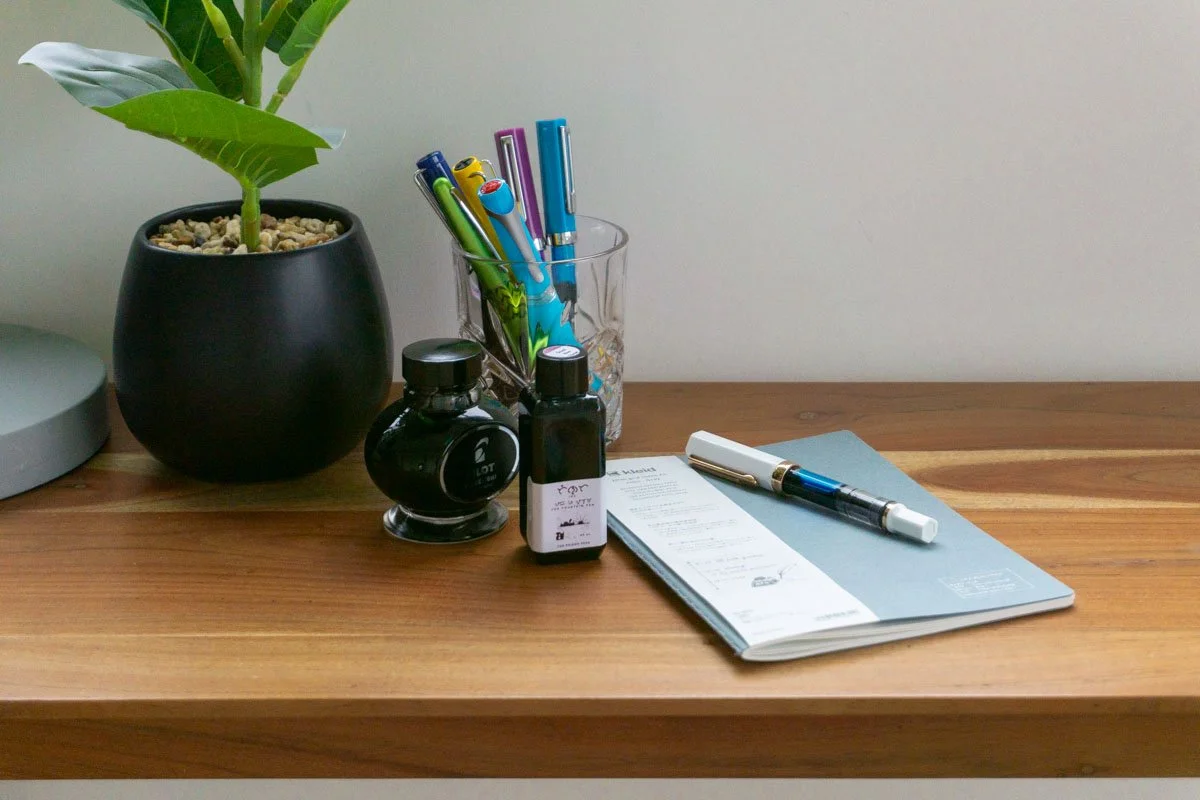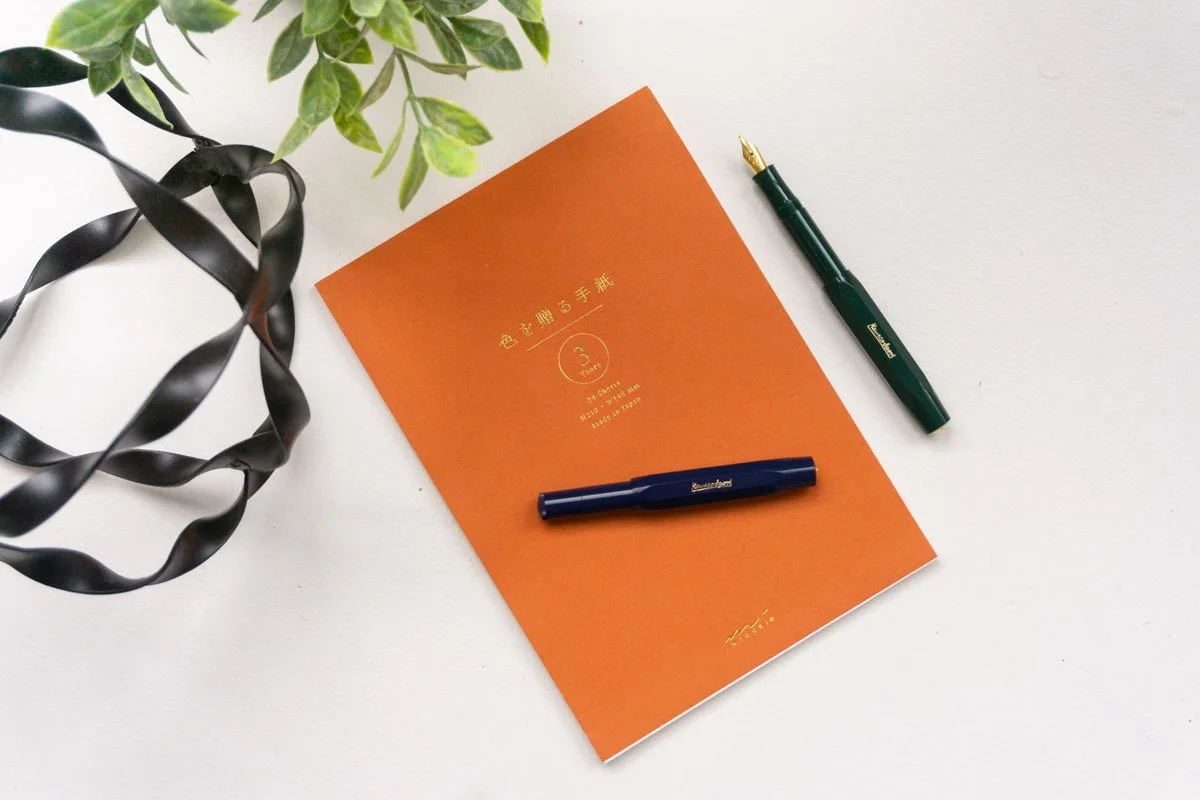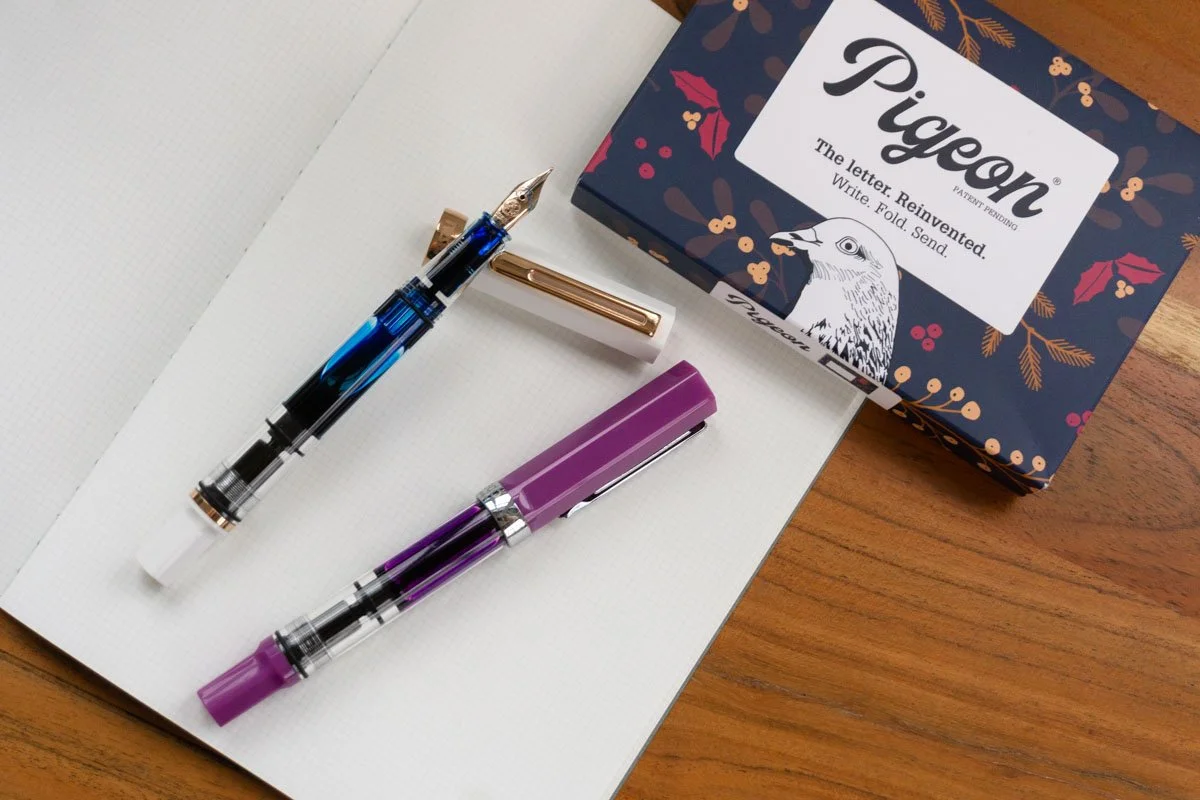A Beginner's Guide to Choosing Your First Fountain Pen
A fountain pen is a wonderful tool to have in your work or study kit. They not only allow for effortless writing, which is very important if you intend on writing for extended sessions, but also opens up a wide range of options for ink colours. The latter is especially useful for organizing ideas when taking notes, but also makes writing by hand infinitely more fun. Because of this, many people also find great enjoyment in journaling or letter writing using their fountain pens.
If you are a beginner to the world of fountain pens, it might be hard to figure out where to start. We believe there are two main criteria to consider when picking out a good beginner fountain pen: whether the pen is comfortable in the hand and whether it is easy to use. As a general rule of thumb, a lighter weight pen with a wider body will generally feel more comfortable in the long run.
Other things you might want to consider are portability and ink capacity. A great fountain pen should make you excited about putting your thoughts down on paper, no matter where you might be. And if you are looking for a that you can carry along with you everywhere you go, then a pen that is small and/or lightweight will certainly help.
The ink capacity, and consequently, the filling system of the pen, may be an important factor to consider, too. Most modern fountain pens use a cartridge system, which allows for simple and mess-free “refilling” of your pen. However, they hold a limited amount of ink (usually less than 1ml), and though that is usually enough to fill up around 10 pages of writing, it may not be sufficient for everyone. If a large ink capacity is important to you, it may be worth considering a pen with a built-in piston filler instead.
Finally, you’ll want to consider nib size. For beginners, we recommend starting with a fine (F) nib for most pens. An F nib is able to handle most papers (even lower quality office copy paper), while still remaining very smooth to use. Though a medium (M) or broad (B) nib may feel even smoother, they lay down more ink, which can result in lots of messy feathering if the paper is of poor quality. If you have particularly small handwriting, you may consider getting an extra fine (EF) nib instead. However, do bear in mind that EF nibs will tend to feel a little bit scratchier as the nib is much narrower.
Phidon’s Top Picks for a Starter Fountain Pen
With all of the above in mind, we want to show you a few of our most popular options for a beginner friendly fountain pen.
LAMY Safari Fountain Pen
Made of durable ABS plastic and packed with a number of thoughtful design features, the LAMY Safari Fountain Pen is a perennial favourite with both first-time and seasoned fountain pen users. The pen features a molded, triangular grip section, which encourages proper pen holding technique and helps to prevent hand strain. The lightweight construction of this pen, combined with its wider body makes the Safari fountain pen a suitable choice for hands of all sizes. Best of the all, the Safari Fountain Pen is fitted with an easily replaceable stainless steel nib. So if you decide later down the line that you’d like a nib with a thinner or broader line width, you can pick up an extra nib from your local pen store and swap it out without having to purchase an entire pen. This kind of flexibility is particularly useful for artists who want to sketch or draw with their fountain pens.
LAMY Safari Fountain Pens in White and Yellow. These pens can be refilled using Lamy’s own ink cartridges, or using a LAMY Z28 cartridge converter.
The LAMY Safari Fountain Pen can be refilled using a proprietary LAMY ink cartridge (available in 7 standard colours), but users can also opt for a LAMY Z28 cartridge converter. This converter, which has a turn piston pump, allows you to refill the pen from any bottled fountain pen ink. With hundreds (or even thousands) of ink colours available from a wide range of brands, you can really take your pick of the litter and get the perfect ink for the occasion.
2. KAWECO Sport Fountain Pen
If keeping your writing kit portable is high on your list of demands, consider the KAWECO Sport Fountain Pen. When capped, this ultra-compact pen measures only 106mm and can easily fit into any pocket. Like the previously mentioned LAMY Safari, the KAWECO Sport is also made of plastic to keep the pen lightweight. This makes the KAWECO Sport an excellent choice for an everyday-carry (EDC) fountain pen.
For those with smaller hands, they may find that the pen is comfortable to hold and write with even without the cap. However, those with larger hands will definitely want to post the cap on the end. By doing so, it transforms the Sport Fountain Pen into a standard, full-sized length. Keeping the cap posted while the pen is uncapped also helps to prevent the pen from rolling off a table, thanks to its signature octagonal shape.
The KAWECO Sport Fountain Pen is compatible with most short international standard ink cartridges. These can be found from a range of brands, including KAWECO themselves, as well as brands like GRAF VON FABER CASTELL and J. HERBIN. Because of its short length, the pen must be fitted with a mini cartridge converter in order to be refilled from a bottle. Full-sized standard cartridge converters will be too long to fit inside the barrel of the KAWECO Sport.
3. TWSBI Eco Fountain Pen
A top pick especially amongst students, the TWSBI Eco Fountain Pen is easy on the wallet and has a much higher ink capacity than most beginner fountain pens thanks to its built-in piston filler body. TWSBI is in fact one of the only brands to offer built-in filling mechanisms at the <$50 price point. The transparent barrel of the pen allows you to keep an eye on the ink level (useful if you’re planning to take your pen with you into the exam room or a very long meeting). To refill this pen, you simply need to unwind the piston from the knob at the end of the pen, submerge the nib into a bottle of fountain pen ink, and turn back the knob to pull up the piston and draw ink into the barrel.
TWSBI Eco Fountain Pen in White Rose Gold and Lilac (now discontinued).
TWSBI produces a few limited edition colours for the Eco Fountain Pens throughout the year. Recent additions included a funky Glow-In-The-Dark Green, a cheerful Cerulean Blue, and an elegant Lilac. These special releases make growing your writing collection super fun, not to mention you’ll have no trouble finding a matching pen for your favourite ink.
4. PILOT Metropolitan Fountain Pen
We’ve covered 3 lightweight fountain pens made of plastic so far, but what if you want a pen that feels slightly heavier? Some people may find that the slightly added weight of a metal body pen can still be quite comfortable, especially when the pen is well-designed with balance and comfort in mind. The PILOT Metropolitan Fountain Pen is one such pen. Made of lacquered brass, the pen feels heavier than the aforementioned LAMY Safari, KAWECO Sport, and TWSBI Eco fountain pens, but is no less comfortable to use. It has a tapered body with a plastic grip section, so it remains easy to hold in the hand.
PILOT Metropolitan Fountain Pen in Green.
The stainless steel nib on this Japanese fountain pen tends to run narrower than its Western counterpart. A fine (F) nib on the PILOT Metropolitan Fountain Pen will feel more akin to an extra fine (EF) on a LAMY or KAWECO fountain pen. So keep this in mind when choosing your nib size for this pen.
The PILOT Metropolitan Fountain Pen is another pen that uses a proprietary cartridge system, with their ink cartridges available in 3 standard colours. Though the pen comes with a squeeze converter (CON-20), we recommend purchasing a CON-40 piston converter to use with the pen instead if you want to refill the pen from a bottle of ink. Compared to the CON-20, the PILOT CON-40 converter can hold a little more ink, and is much easier to operate than the squeeze converter.
A FEW NoteS on Basic Fountain Pen Care
Use your pen regularly. Write with your pens at least once or twice a week (even if you’re just scrawling down a few lines for a to-do list). It keeps the ink flowing through the feed of the pen and helps to prevent the pen from drying out. Depending on the ink used, that can sometimes lead to stubborn clogs which can take lots of time and effort to clean out.
Use a light hand. If you have been writing with ballpoint pens, you may be used to applying a lot of pressure against the page as you write. Fountain pens are all about capillary action! That means ink is drawn from the reservoir in the pen through the feed and tines of the nib on to the paper without requiring any pressure at all. If you find that the pen is not making a mark on the page when you first uncap it to start writing, simply wipe down the nib with a damp paper towel. This should re-lubricate any dried ink between the tines and restart the ink flow.
Use only fountain pen inks with your pen. There are many ink products on the market, but only ink specifically formulated for fountain pens are safe for use with your brand new fountain pen! Inks labelled as “India ink”, “calligraphy ink” or “drawing ink” often contain gum arabic or shellac, both of which will clog up and destroy the fine feeds of your fountain pen. They are very difficult (and almost impossible) to get out of your pens. For a fuss-free experience, we recommend beginners to start with a classic dye-based fountain pen ink like a PILOT Black or LAMY Blue.
Use only water or a diluted soap solution to clean your fountain pen. You may be tempted to use alcohol or other harsh chemicals to clean your fountain pen. Don’t. A good flush (or a longer soak) using room temperature water from the tap is sufficient to clean out your fountain pens in most situations. If you have let your pen dry out after an extended period of non-use, you can get a pen flush or simply make your own pen cleaning solution (1:10 ratio of dish detergent to water). Using harsher chemicals can degrade the metal and/or plastic components of your pens and lead to permanent damage.
With these great recommendations and simple tips in mind, you’re ready to pick out your first fountain pen. We’re sure no matter which pen you choose, you will experience lots of fun and enjoyment using your new pen. Stay tuned for the next part of this series: A Beginner’s Guide to Inks!
Have a question? Put it in the comments below and we will answer it in an upcoming fountain pens FAQ post!





